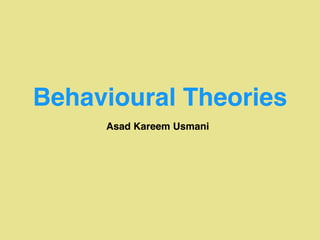
Behavioural Theories of an Organisationa
- 1. Behavioural Theories Asad Kareem Usmani
- 2. Behavioural Theories Human Relation Theory Human Behaviour Theory
- 3. HUMAN RELATION THEORY ❖ There was an increased need to understand human behaviour at work place. ❖ The credit of development of human relation approach is given to Elton Mayo. ❖ Elton Mayo and colleagues conducted experiments called Hawthorne Experiments at Hawthorne plant of Western Electric Company. ❖ This was the first ever intensive and systematic study of human factor at work place.
- 4. The Hawthorne Experiments ❖ Conducted at Hawthorne Plant of Western Electric company. It manufactured telephone system bell. ❖ The company employed 30,000 people at the time of experiments. ❖ The research was conducted in four phases from 1924 to 1932
- 5. Phases of the experiments ❖ Phase I : Illumination Experiments ❖ Phase II: Relay Assembly Test Room Study ❖ Phase III: Mass Interview Program ❖ Phase IV: Bank wiring observation room experiment
- 6. Phase I :Illumination experiments ❖ Effect of lighting(illumination) was studied on productivity of two groups, One for which lighting condition were changed and one for which lighting condition remained constant. ❖ For the first group, when lighting condition was improved the productivity went up. When lighting condition was reduced there was no reduction in productivity until the lighting was reduced to a very low level and affected visibility. ❖ For the second group lighting was maintained at constant level, the productivity gradually increased. ❖ It was concluded that lighting do not have any impact on productivity and there was something else that was affecting it.
- 7. Phase II: Relay Assembly Test Room Study ❖ A small group of six girls were asked to work in a test room. ❖ Changes in working condition were tried as, less working hours, better working condition, better wages, proper rest periods, free interaction among members. ❖ There was friendly and informal supervision. ❖ The productivity increased, however when these condition were withdrawn, the productivity did not reduced. ❖ It was concluded that there was something other than these factors that was responsible for productivity. ❖ There was social & psychological need of workers like sense of acceptance, recognition, participation in decision making, freedom to work and informal relationship were responsible for this.
- 8. Phase III: Mass Interview Program ❖ Mayo and colleagues conducted interview of more than 20,000 employee. ❖ The interview was conducted to know about their superior, jobs and job condition. ❖ The objective was to determine employee’s attitude towards company, supervision, remuneration. ❖ The method was kept informal ❖ Responses highlighted that if employees interacted with mangers openly their morale and productivity went up. ❖ It was also found that: ‣ Worker’s behaviour was influenced by group behaviour. ‣ The workers interpret situations per their position in the organisation. ‣ The social demands of worker are influenced by social experience.
- 9. Phase IV: Bank wiring observation room experiment ❖ A group of 14 workers were selected to attach wires to switches for some equipment that was used in telephone exchange. ❖ No changes in conditions were made. ❖ Hourly wage rate and bonus based on performance were announced by the management. ❖ It was observed that without formal declaration workers made standard target that was less than the company’s target. ❖ Social pressure was created to ensure no member exceeded the group target. ❖ The following reasons were identified for restricted output: ‣ If worker produced more some would be turned out as less employee would be needed ‣ They feared that if they achieved the target management would increase target. ‣ They supported slow workers.
- 10. Results from the Experiments ❖ There is no direct relation between productivity and physical factors. ❖ Worker is not motivated by financial incentives only, he is a ‘social man’ with strong desire for interaction and non financial incentives. ❖ Informal groups are as important as the formal groups and people behave according to group norms. ❖ Work is group activity and not just task performed by workers. ❖ Worker work like a family and there are no conflicts among them. ❖ Non financial incentives like morale, security, recognition and praise are important.
- 11. HUMAN BEHAVIOUR THEORY ❖ The theory is based in the work of behavioural scientist Maslow and McGregor. ❖ It apply the concepts of Psychology, Sociology and Anthropology to the work place. ❖ The behaviour science approach emphasise on scientific research as basis of developing theories about human behaviour in the organisation. ❖ The behavioural scientist believe that people have different needs, values, attitudes and perception and therefore acts differently in same situation.
- 12. Features of Behavioural Theory • Emphasises on participative and group decision making rather than individual decision making. • Focus on self control and self direction. • It advocated positive measures to improve performance. • People behaviour in group is different to their individual behaviour. • There is huge impact on informal group on formal functioning and efficiency. • Human behaviour is need based and it is because of this that each person behave differently under same situation. • Conflict is good for human development.